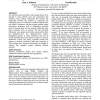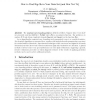26354 search results - page 33 / 5271 » How we refactor, and how we know it |
ACL
1998
13 years 9 months ago
1998
Nonconcatenative constraints, such as the shuffle relation, are frequently employed in grammatical analyses of languages that have more flexible ordering of constituents than Engl...
OZCHI
2006
ACM
14 years 1 months ago
2006
ACM
This paper presents thoughts to extend our understanding of bodily aspects of technology interactions. The aim of the paper is to offer a way of looking at the role our kinaesthet...
PDC
2004
ACM
14 years 1 months ago
2004
ACM
The aim of Participatory Design (PD) is to involve the users in the design. Even though the research has shown the success of PD projects in empowering users, little has been said...
CHI
2010
ACM
14 years 2 months ago
2010
ACM
Is a polarized society inevitable, where people choose to be exposed to only political news and commentary that reinforces their existing viewpoints? We examine the relationship b...
IDA
1997
Springer
13 years 12 months ago
1997
Springer
The empirical curve bounding problem is de ned as follows. Suppose data vectors X Y are presented such that E(Y i]) = f(X i]) where f(x) is an unknown function. The problem is to a...


